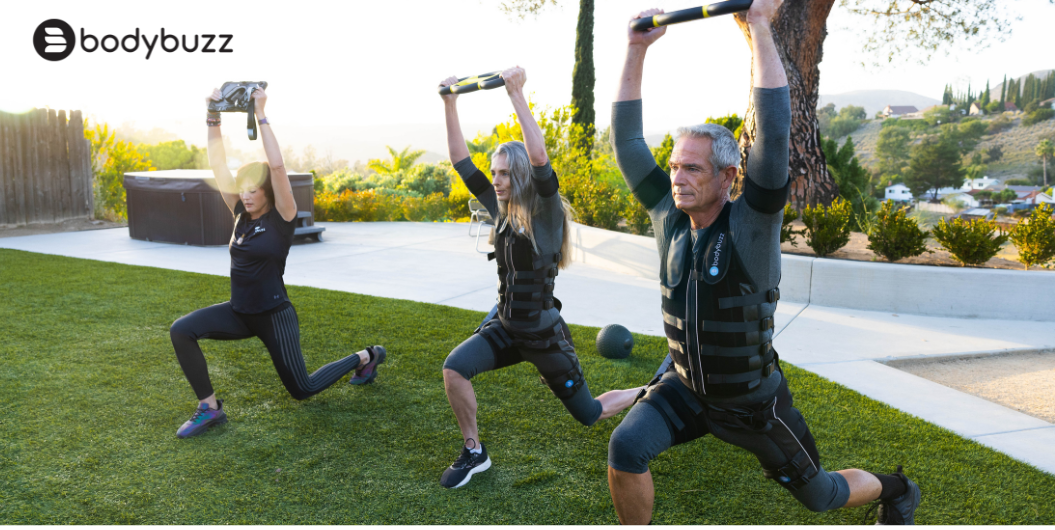EMS Systematic Review 2024
Who’s better, Jordan or Kobe?
The debate between two of the greatest basketball players completely depends on the criteria chosen: Championships? Stats? Impact on the league? Ability to close games? You might get a different answer depending on how much weight you attribute to each category.
Despite living in Los Angeles, the correct answer is Jordan.
When comparing traditional weight training to Whole Body EMS (EMS), we also need to select the comparison criteria, with results being the obvious first choice, but with more categories to follow: time, space, equipment required, accessibility for different populations, and risk of injury are a few that come to mind.
Let me start by saying that I have absolutely nothing against traditional weightlifting. Even though I do EMS workouts, I also lift weights. Any client of mine will tell you that I have always recommended doing EMS 2x/week if you don’t do any resistance training, or 1x/week if you do some weightlifting elsewhere. Both modalities are great and there are reasons to do one, the other, or both. Doing neither is not an option!
The 2024 systematic review comparing the efficacy of EMS training on muscle strength, anthropometrics, and performance in active young adults would have you believe that both EMS training and traditional resistance training are equivalent… if you stop at the abstract or jump straight to the conclusion.
Indeed, the abstract and conclusion of the review suggest that EMS and traditional workouts will get you similar results. The problem with this summary is that it’s saying that riding a horse and driving a car are the same since both get you from point A to B. This conclusion completely ignores that horses can’t play your favorite podcast interview.
Strangely, the introduction in this systematic review lays out what are, in my opinion, some of the most important benefits of EMS:
- EMS is time-efficient due to stimulating multiple muscle groups at once.
- EMS can help people who are afraid of movement or have aches and pains to exercise, also known as kinesophobia.
- EMS reduces abdominal fat and increases muscle mass, helping to combat obesity and related diseases.
- EMS shows promise as a treatment for lower back pain.
- EMS increases muscle strength and size in inactive and elderly populations.
In a country where most of the population is overweight and under-exercises due to factors such as lack of time, injury, fear of injury, and lack of knowledge, these benefits are clutch.
The review summarizes the findings of several studies so I want to go through each one and keep a tally of points for Whole Body EMS (EMS) versus Traditional Training (TT).
Study 1: EMS improved VO2 max, aerobic performance, and jump height in recreational runners. (EMS +1)
Study 2: All groups (EMS low freq, EMS high freq, traditional training) improved strength and power similarly. (Tie)
Study 3: No significant differences between EMS and traditional training for strength, power, or speed in active females. (Tie)
Study 4 (soccer): EMS improved strength, speed, jumping, and kicking in elite soccer players compared to jump training. (EMS +1)
Study 5 (football): EMS improved strength compared to traditional training and jump training in male football players. (EMS +1)
Study 6 (softball): EMS with dry swing training improved strength and batting velocity more than dry swing training alone in female softball players. (EMS +1)
Study 7 (softball): Traditional resistance training increased strength more than EMS in female softball players, though both improved. (TT +1)
Study 8: EMS and traditional training similarly improved strength in trained women compared to control. (Tie)
Study 9: EMS improved jump power, skating speed, and force in amateur ice hockey players. Effects diminished after stopping EMS. (EMS +1)
Study 10: No difference between EMS jump training and traditional jump training for endurance in amateur football players. (Tie)
Study 11: EMS combined with traditional training improved strength more than traditional training alone in youth soccer players. (EMS +1)
Tally: EMS: 6 points, Traditional Training: 2 points, Ties 3
Despite this tally, the systematic review still concludes that EMS seems effective compared to no training at all, but not necessarily better than traditional exercise methods for building muscle, reducing fat, or improving performance. It also says that EMS can yield comparable strength results to traditional weightlifting in less time with less risk of injury because of its low-impact nature while helping reduce lower back pain in some cases, and is a great option for obese and elderly populations.
I will let you draw your own conclusion. In the meantime, if you live in Los Angeles or San Diego, we offer at-home EMS personal training services or you can join one of our EMS small group training classes in Costa Mesa.
Conrad
Managing Director
Bodybuzz


